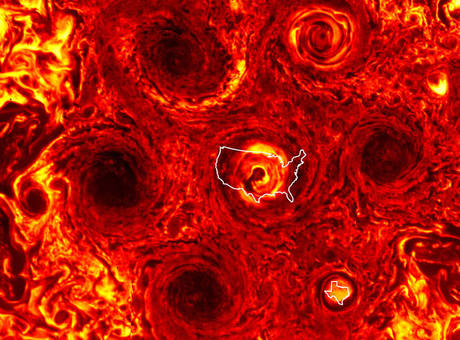Gigantic cyclones have formed in the area around the South Pole of Jupiter; they are seven and neighbors among the lotus, each of them is at least as vast as the United States and together they appear as a hexagon of red and yellow velvet with an almost hypnotic effect. The Juno mission of NASA photographed them thanks to the Jiram tool (Jovian InfraRed Auroral Mapper), it is one of the two Italian instruments on board the probe, realized by Leonardo under the coordination of the Italian Space Agency (ASI) and in collaboration with the National Institute of Astrophysics (Inaf); the other tool is at the service of radioscience, is called KaT (Ka-band Translator) and is made by Thales Alenia Space (Thales-Leonardo) and Sapienza University of Rome, with funding from the ASI.
Cyclones on Jupiter (source: NASA / JPL-Caltech)
Jupiter is a turbulent place and the great red spot that distinguishes it is the result of its most famous storm, but when the Juno probe arrived in the planet's orbit in 2016, it discovered that the polar regions of the gas giant were even more restless. Nine storms raged at the North Pole: one very large and the others arranged around it, while at the South Pole there were six of them, as vast as the United States: five were arranged in an almost perfect pentagon around a central cyclone.
The central cyclone is almost as extensive as the United States (source: NASA / JPL-Caltech / SwRI / ASI / INAF / JIRAM)
Not much was known about these storms: were they permanent or would they be swept away soon? Thanks to Juno's data we now know that they are rather persistent and in the most recent close-up overflight, which occurred at a distance of 3,500 kilometers, Juno photographed something new: the storms of the South Pole no longer had the shape of a pentagon, but of a hexagon thanks to a newcomer.
In the South Pole of Jupiter six cyclones form a hexagonal structure around a central storm (source: NASA / JPL-Caltech / SwRI / ASI / INAF / JIRAM)
"The data of the Jiram instrument indicate that we have gone from a pentagon of cyclones to a hexagonal arrangement," observes the astrophysicist Alessandro Mura, from Inaf. The newcomer, he continues, "is smaller than its six 'brothers': it has the size of Texas. Perhaps Jiram data from future flights will show that the cyclone will reach the same size as its neighbors". These strange configurations of storms do not appear elsewhere in the Solar System and studying them can help to better understand the dynamics of the atmospheres of the gas giants.

